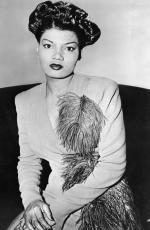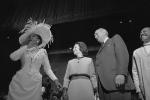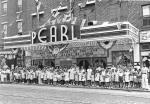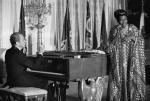![header=[Marker Text] body=[Bailey, who lived here as a youth, became one of America's most prominent entertainers. She performed with the big bands during the 1940s and gained her greatest fame in the Broadway production of <i>Hello, Dolly</i>.] sign](http://explorepahistory.com/kora/files/1/10/1-A-25C-139-ExplorePAHistory-a0h7x7-a_450.jpg)
Mouse over for marker text
Name:
Pearl Bailey
Region:
Philadelphia and its Countryside/Lehigh Valley
County:
Philadelphia
Marker Location:
1946 N 23rd St., Philadelphia
Behind the Marker
Some performers dazzle us with talent, others with their personality, and then there was the brassy, sassy, classy, and thoroughly unique Pearlie Mae, a vocal stylist who peppered her songs with droll observations and wry asides. Pearl Bailey was funny, very funny; her comic touch - with a melody or a quip - was as earthy as her barrel-deep voice and as sophisticated as a grande dame. "I call myself a humorist," she once explained. "I tell stories to music and, thank God, in tune." With her songs …and with her audiences … especially with her audiences.
She was a large woman, a commanding trouper who celebrated her vaudeville roots. With her innate warmth, her high-voltage smile, and an uncanny knack for connecting with people, Bailey was such a consummate and beloved entertainer that even presidents dropped their august veneers in her embracing presence: Lyndon Johnson once sang with her, and Richard Nixon designated her the nation's "Ambassador of Love." Hers was the kind of improbable American success story that Hollywood once reveled in building musical biographies around.
She was born Pearl Mae Bailey, in Newport News, Va., on March 29, 1918, but grew up, for the most part, in Philadelphia, where her mother resettled with her four children - Pearl was the youngest - after divorcing her father, an evangelical minister, and remarrying. Pearl originally wanted to be a teacher, but left William Penn High School at fifteen when she realized she wanted to be an entertainer even more. Singing and dancing were certainly an important part of her childhood; she began doing both in her father's church when she was just three, and, indeed, much of her talent was shaped by the lively worship of the holy roller churches she attended.
Philadelphia, in those years, was an important hub on the vaudeville circuit. Pearl's older brother, Bill Bailey, a dancing protégé of legendary hoofer Bill "Bojangles" Robinson, had already made a name for himself when Pearl decided to enter a talent contest at the aptly named Pearl Theater, where he was appearing. She won - $5 and a two-week engagement. She won another contest that summer in Washington, D.C., then honed her talent - and personality - in the vaudeville theaters of Scranton, Wilkes-Barre, Pottsville, and other Pennsylvania coal towns before moving on to the smoky night clubs of Baltimore and Washington. Barely twenty, she began touring as a featured vocalist with a string of swing-era Big Bands, and when World War II broke out, began a lifelong association with the USO, entertaining American troops.
Bailey's big break came in 1944. The Village Vanguard, a popular New York club, booked her as a solo performer. More importantly, the club's owner encouraged her to engage more with her audiences between songs - and even in songs - with the endearingly mischievous, suggestive, good-natured chit-chat and bons mots that ultimately became her on-stage signature. Her popularity soared, and she quickly rose from nightclub headliner to big-band star with Cab Calloway's orchestra, and then to Broadway sensation when lyricist Johnny Mercer and composer Harold Arlen tapped her in 1946 for their all-black musical, St. Louis Woman. "Pearl Bailey pulls the show up by its shoestrings every time she makes an entrance," one reviewer rhapsodized. The theater establishment agreed, honoring her as the best newcomer to Broadway that year.
For the next five decades, Bailey remained a multi-media star. She moved easily from the stage to the recording studio to the screen - most notably in movies like 1954"s Carmen Jones, Oscar Hammerstein's languid, all-black adaptation of the opera "Carmen;: the 1956 comedy, That Certain Feeling, with Bob Hope; and the 1959 film version of George Gershwin's classic Porgy and Bess - and, of course, back to the intimacy of the nightclubs and cabarets that best showcased her personality. Her style also translated well into television. From the late 1950s to the early 1970s, she regularly appeared on The Ed Sullivan Show, The Perry Como Show, and other variety programs, briefly hosted her own Pearl Bailey Show, and later had a supporting role on the sitcom Silver Spoons. She also managed to write six books, including two volumes of memoirs.
Oscar Hammerstein's languid, all-black adaptation of the opera "Carmen;: the 1956 comedy, That Certain Feeling, with Bob Hope; and the 1959 film version of George Gershwin's classic Porgy and Bess - and, of course, back to the intimacy of the nightclubs and cabarets that best showcased her personality. Her style also translated well into television. From the late 1950s to the early 1970s, she regularly appeared on The Ed Sullivan Show, The Perry Como Show, and other variety programs, briefly hosted her own Pearl Bailey Show, and later had a supporting role on the sitcom Silver Spoons. She also managed to write six books, including two volumes of memoirs.
Bailey's most celebrated triumph arrived in an unlikely form - as the redoubtable Yonkers matchmaker Dolly Levi in the 1967 revival of the 1964 Broadway smash, Hello, Dolly! The role was so identified with Carol Channing, the ash-pale actress who created it, that the producers daringly reconceived the play with an all-black cast at the height of the Civil Rights movement. Bailey, gushed the New York Times critic, "took the whole musical in her hands and swung it around her neck as easily as if it were a feather boa." The show ran for two years, and she later toured with it twice. At a special performance in Washington with Lyndon Johnson in the audience, she waved to the president at the curtain and announced, "I didn't know this child was going to show up," then playfully reduced the leader of the Free World to chorus boy, gleefully coaxing him to the stage for a reprise of the show's title song.
If all of that says much about Pearl Bailey, it barely scratches the surface of who she was and what she believed. In an age when interracial unions were virtually taboo, she married white jazz drummer Louis Bellson Jr. in 1952, simply because she loved him, and they remained together until her death in 1990. As a humanitarian, she regularly spoke out for the oppressed and disenfranchised - "Every man has a place in this world," she insisted, "but no man has a right to designate that place" - and while the old USO trouper was always willing to spread American good will, she warned President Nixon when he offered her his fanciful ambassadorship in an era troubled by racial tensions, that "I will do anything for my country, but no one can use me."
Bailey was so noted for her conscience and convictions - "I bleed for the world," she liked to say, "and if we get a few more bleeders out there, we'll get something done" - that three future presidents - Ford, Reagan (who also bestowed on her the Presidential Medal of Freedom), and Bush gave her the more serious appointment of special representative to the United Nations. When Georgetown University bestowed an honorary degree on her in 1970, the one-time high-school dropout decided she would earn one properly - through hard work and study. In 1985, at the age of sixty-seven, she graduated from Georgetown with a degree in theology. She considered it, unquestionably, her proudest achievement.
She was a large woman, a commanding trouper who celebrated her vaudeville roots. With her innate warmth, her high-voltage smile, and an uncanny knack for connecting with people, Bailey was such a consummate and beloved entertainer that even presidents dropped their august veneers in her embracing presence: Lyndon Johnson once sang with her, and Richard Nixon designated her the nation's "Ambassador of Love." Hers was the kind of improbable American success story that Hollywood once reveled in building musical biographies around.
She was born Pearl Mae Bailey, in Newport News, Va., on March 29, 1918, but grew up, for the most part, in Philadelphia, where her mother resettled with her four children - Pearl was the youngest - after divorcing her father, an evangelical minister, and remarrying. Pearl originally wanted to be a teacher, but left William Penn High School at fifteen when she realized she wanted to be an entertainer even more. Singing and dancing were certainly an important part of her childhood; she began doing both in her father's church when she was just three, and, indeed, much of her talent was shaped by the lively worship of the holy roller churches she attended.
Philadelphia, in those years, was an important hub on the vaudeville circuit. Pearl's older brother, Bill Bailey, a dancing protégé of legendary hoofer Bill "Bojangles" Robinson, had already made a name for himself when Pearl decided to enter a talent contest at the aptly named Pearl Theater, where he was appearing. She won - $5 and a two-week engagement. She won another contest that summer in Washington, D.C., then honed her talent - and personality - in the vaudeville theaters of Scranton, Wilkes-Barre, Pottsville, and other Pennsylvania coal towns before moving on to the smoky night clubs of Baltimore and Washington. Barely twenty, she began touring as a featured vocalist with a string of swing-era Big Bands, and when World War II broke out, began a lifelong association with the USO, entertaining American troops.
Bailey's big break came in 1944. The Village Vanguard, a popular New York club, booked her as a solo performer. More importantly, the club's owner encouraged her to engage more with her audiences between songs - and even in songs - with the endearingly mischievous, suggestive, good-natured chit-chat and bons mots that ultimately became her on-stage signature. Her popularity soared, and she quickly rose from nightclub headliner to big-band star with Cab Calloway's orchestra, and then to Broadway sensation when lyricist Johnny Mercer and composer Harold Arlen tapped her in 1946 for their all-black musical, St. Louis Woman. "Pearl Bailey pulls the show up by its shoestrings every time she makes an entrance," one reviewer rhapsodized. The theater establishment agreed, honoring her as the best newcomer to Broadway that year.
For the next five decades, Bailey remained a multi-media star. She moved easily from the stage to the recording studio to the screen - most notably in movies like 1954"s Carmen Jones,
Bailey's most celebrated triumph arrived in an unlikely form - as the redoubtable Yonkers matchmaker Dolly Levi in the 1967 revival of the 1964 Broadway smash, Hello, Dolly! The role was so identified with Carol Channing, the ash-pale actress who created it, that the producers daringly reconceived the play with an all-black cast at the height of the Civil Rights movement. Bailey, gushed the New York Times critic, "took the whole musical in her hands and swung it around her neck as easily as if it were a feather boa." The show ran for two years, and she later toured with it twice. At a special performance in Washington with Lyndon Johnson in the audience, she waved to the president at the curtain and announced, "I didn't know this child was going to show up," then playfully reduced the leader of the Free World to chorus boy, gleefully coaxing him to the stage for a reprise of the show's title song.
If all of that says much about Pearl Bailey, it barely scratches the surface of who she was and what she believed. In an age when interracial unions were virtually taboo, she married white jazz drummer Louis Bellson Jr. in 1952, simply because she loved him, and they remained together until her death in 1990. As a humanitarian, she regularly spoke out for the oppressed and disenfranchised - "Every man has a place in this world," she insisted, "but no man has a right to designate that place" - and while the old USO trouper was always willing to spread American good will, she warned President Nixon when he offered her his fanciful ambassadorship in an era troubled by racial tensions, that "I will do anything for my country, but no one can use me."
Bailey was so noted for her conscience and convictions - "I bleed for the world," she liked to say, "and if we get a few more bleeders out there, we'll get something done" - that three future presidents - Ford, Reagan (who also bestowed on her the Presidential Medal of Freedom), and Bush gave her the more serious appointment of special representative to the United Nations. When Georgetown University bestowed an honorary degree on her in 1970, the one-time high-school dropout decided she would earn one properly - through hard work and study. In 1985, at the age of sixty-seven, she graduated from Georgetown with a degree in theology. She considered it, unquestionably, her proudest achievement.









